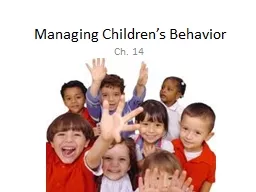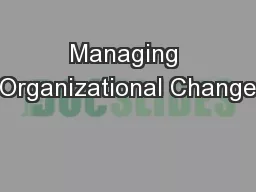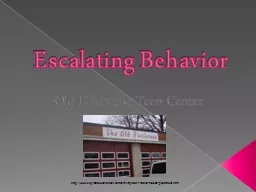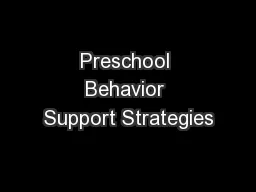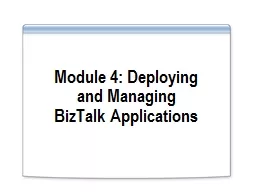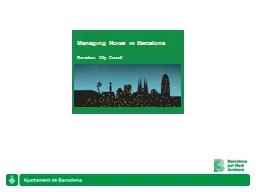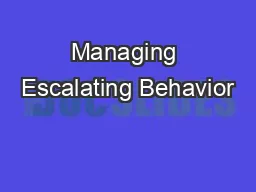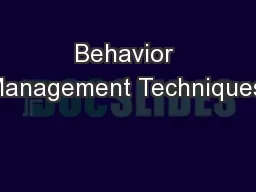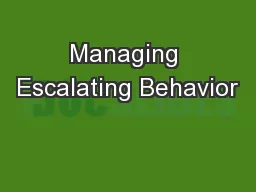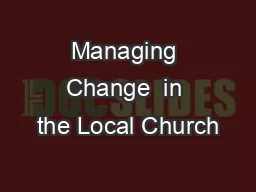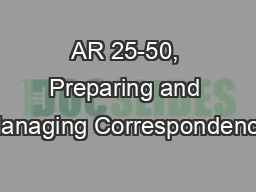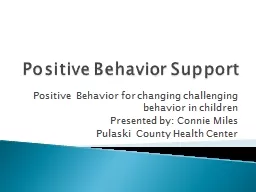PPT-Managing Children’s Behavior
Author : trish-goza | Published Date : 2016-07-14
Ch 14 Managing Behavior Children of different ages have different needs and they behave differently to have their needs met Infants Have many physical needs Crying
Presentation Embed Code
Download Presentation
Download Presentation The PPT/PDF document "Managing Children’s Behavior" is the property of its rightful owner. Permission is granted to download and print the materials on this website for personal, non-commercial use only, and to display it on your personal computer provided you do not modify the materials and that you retain all copyright notices contained in the materials. By downloading content from our website, you accept the terms of this agreement.
Managing Children’s Behavior: Transcript
Ch 14 Managing Behavior Children of different ages have different needs and they behave differently to have their needs met Infants Have many physical needs Crying What might it mean Diaper Changing. 57522573645736557347VVWHP57347DYDLODEOH57347WKDW57347LQFOXGHV57347DOO57347RI57347WKH57347HVVHQWLDO57347 57443574555745357456574555745457445574545746057459573765745457445574455744457445574445737657446574555745857376574455745957460574415744257452574495 Chapter 2. Images of Managing Change . Images of Organizations. Affect our interpretations of what we think is going on. What we think needs to happen. How we think things should happen. aka “metaphors”, “frames”, or “perspectives”. Old Firehouse Teen Center. http://www.city-data.com/forum/northern-virginia/1178545-mclean-photo-tour.html. Signs of Escalating Behavior. Arguing . Non-Compliance. Darcy Burns. Dawn Appleby-Quackenbush. Preschool Behavior Specialist . Regional Special Education-Technical Assistance Center (RSE-TASC). Objectives. Understand the importance of dealing with challenging behaviors in the Preschool Setting. Lesson 1: Deploying a BizTalk Application. Lesson 2: Managing a BizTalk Application. Overview. Lesson 1: Deploying a BizTalk Application. How Deployment Works. What Is a BizTalk Application?. Application Deployment Steps. Democracy. Elections in. Iran. RELATED VOCABULARY:. Electoral Role of the Guardian Council. Jurist’s Guardianship. Equality with Difference. Theocratic Democracy. Elite Recruitment. Managing. Democracy: Iran. Barcelona City Council. Overview. Managing Noise in Barcelona. 1. Historical and geographical context. 2. Noise Map. 3. Noise limits. 4. Measures taken. Diagnosis. Control and prevention. Noise abatement. Ronald E. Adams, P. E.. Chief, . Railroads & . Harbors Section. Wisconsin DOT. Starting Point. Initially rail office focus was:. Overseeing Amtrak service. Representing WisDOT on organizations working cooperatively to develop funding programs. Individual Tier II. Purpose. PURPOSE. Enhance understanding & ways of escalating behavior sequences. Understandin. g the Escalation Cycle. Best practice. . Considerations. Your action planning how to share with staff ba. How . to Manage . Tough Kids. Tonya N. Davis, Ph.D., BCBA-D. Who Are Tough Kids?. Demonstrate . Behavior Excess. Behavior Deficits. Who Are Tough Kids?. Behavior Excess. Argue. Destruct property. Noncompliant. Individual Tier II. Purpose. PURPOSE. Enhance understanding & ways of escalating behavior sequences. Understandin. g the Escalation Cycle. Best practice. . Considerations. Your action planning how to share with staff ba. Vibrant Church Renewal . Evangelism Ministries . USA/Canada Region. Managing Change in the Local Church. The purpose of this module is to:. Encourage participants to see themselves . as . change agents God will use. Records Management and Declassification . Agency. AR 25-50, Preparing and Managing Correspondence. Correspondence management is governed by AR 25-50, Preparing and Managing Correspondence. . As proponent, RMDA prescribes (on behalf of Secretary of the Army) Department of the Army policies, procedures, and standardized formats for preparing and processing Army memorandums and letters.. Positive Behavior for changing challenging behavior in children. Presented by: Connie Miles. Pulaski County Health Center. Please turn off Cell Phone . Restroom. Food and Drinks. Welcome everyone. Objectives .
Download Document
Here is the link to download the presentation.
"Managing Children’s Behavior"The content belongs to its owner. You may download and print it for personal use, without modification, and keep all copyright notices. By downloading, you agree to these terms.
Related Documents

